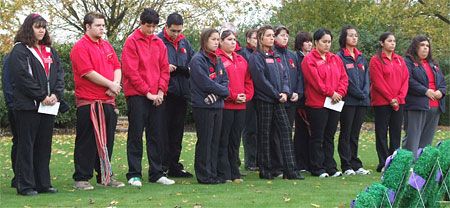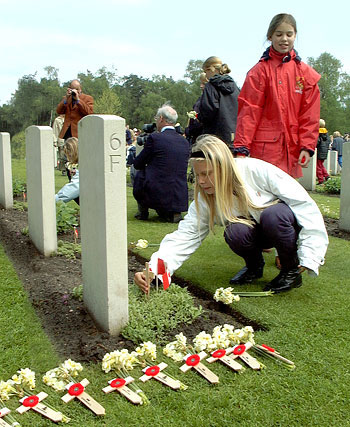Ways To Remember
This publication is available upon request in alternate formats.
PDF Version
Attending Remembrance Day ceremonies on November 11th is a well known way to honour the men and women who served Canada in times of war, military conflict and peace. There are many other ways, throughout the year, to remember the sacrifices and achievements of the one and a half million brave Canadians who served, and continue to serve, our country at home and abroad, and the more than 118,000 men and women who died so that we may live in peace and freedom today. Taking an active role to remember these people is one way to say "thank you."
Share
- Share in an online collaborative space or chat room, in a class driven group discussion about remembrance.
- Share essays, poems and creative writing about remembrance. Create a classroom blog, and then broadcast it up onto a screen at the front of the class, or share stories on your school's website.
- Spread the word about Veterans' Week, Remembrance Day, and commemorative events with social media by using our mobile app Veterans Matter, by liking us on the Veterans Affairs Canada "Canada Remembers" Facebook page, or by following Veterans Affairs Canada on Twitter.
Invite
- Invite a Veteran or a Canadian Armed Forces member as a Guest Speaker to come and speak to your class or community organization.
Watch or Listen
- Listen to interviews with Veterans in the First World War Audio Archives.
- Watch La force francophone and learn about French-speaking Canadians who served in the Second World War.
- Watch The Land of the Morning Calm – Canadians in Korea 1950-1953 which presents Korean War history, archival footage, interviews with Veterans of the Korean War and an interactive comprehensive history calendar.
- Watch a collection of online interviews through a searchable database, with Veterans from across Canada in "Heroes Remember."
- Watch Learning Videos and "Heroes Remember" Mini-Documentaries about the First World War, Second World War and the Korean War.
- Watch the Veterans' Week Vignette.
- Watch military and remembrance themed videos from the Historica Heritage Minute Military Themed Collection.
Read
- Do a novel study, individually or as a group. Choose a fictional or historic book with a storyline based on remembrance, Canada's war or peacekeeping involvement.
- Read historical information sheets online.
- Read online editions of the Canada Remembers Times.
- Read the poem In Flanders Fields, and about Lieutenant Colonel John McCrae who wrote it.
Write
- Play the role of a war correspondent. Write headlines, news stories, going back in time for the First and Second World Wars, or the Korean War, or a war correspondent from a more recent conflict.
- Write about scientific and technological innovations developed in times of war.
- Write to the troops, and let your Canadian Armed Forces members know you appreciate their service by sending a message using the Department of National Defence website.
- Write to Veterans and Canadian Armed Forces members, by participating in the "Peace cards e-cards," or "Valentines for Vets" projects.

Canadian youth pause for silence at the Passchendaele Memorial, Passchendaele, Belgium, October, 2005. (Veterans Affairs Canada)
Be Active
- Wear a poppy.
- Lay a wreath at the cenotaph with classmates and friends.
- Plant poppies, tulips, a tree or an entire garden of remembrance.
- Read about peace cranes, and then fold and display origami peace cranes.
- Learn about Mark Isfeld and "Izzy" dolls, their distribution, and make "Izzy" dolls to send to children in other countries.
- Attend a Remembrance Day ceremony. To find a ceremony visit our online calendar of events, or use the Veterans Matter mobile app, available all year.
- Pause for two minutes of silence at 11:00 a.m. on November 11.
- Plan and participate a commemorative ceremony at school or with a community group, using our Guide to Commemorative Services.
- Organize a candlelight tribute ceremony at a cemetery to remember those who died during military service to Canada.
- Participate in the Royal Canadian Legion Annual Literary and Poster Contest that is open to all Canadian school children.
- Visit your local cemetery and pay respect to a Veteran's grave.
- You could also adopt a Veteran's grave in your community. With the permission of the person's family or the cemetery, visit and take care of the grave. You could dig weeds, plant flowers or clean the headstone.
- Connect with your municipal government and discuss options to have a new or existing street named after a local Veteran to honour their legacy.
Research
- Research the story of a family member, friend, alumni from your school or member of your community who served Canada in wartime or peacetime. If they died in service, you may wish to search for them on the Canadian Virtual War Memorial.
- Interview a Veteran. Ask about his or her wartime experiences and contributions to the war effort.
- Find evidence that citizens in your community participated in the war-things such as memorials, Veterans' graves, plaques or honour rolls in churches. Visit the local cenotaph or war memorial to study its inscription. Make a map of the community and mark where war memorials/statues/monuments are located. Research what they commemorate. Search for memorials in your community on the Department of National Defence website.
- Research Canadian memorial sites located in Canada such as the Canadian National War Memorial, the Tomb of the Unknown Soldier or the Animals in War Dedication.
- Research the contribution of Aboriginal, Asian-Canadian, Black Veterans or Women's Experiences in war. Present your findings to your classmates.
- Research and prepare a report on the various war orders, decorations and medals awarded to Canadians. Look at reasons why specific medals are awarded, their "order of precedence," and at the stories of people who have earned certain ones. Read about the Victoria Cross and Canadian Recipients of the Victoria Cross.

Dutch children place a Canadian flag at a grave site in Holland. May 2000. (Veterans Affairs Canada)
Activities
- Prepare a graph showing various General Statistics on Canada's involvement in the First or Second World War, and the Korean War. Compare the numbers of participation and casualties to the population of your school, town, city or province. How do these statistics compare to other countries involved in the war?
- Create a war memorabilia exhibit using photographs, newspaper articles, artifacts and digital images of community members who served in the military. Invite family members and the public to visit.
- Create an Honour Roll using the Canadian Virtual War Memorial for people who served and died from your community, and read their names during morning announcements on the date in which they died in service.
- Prepare a menu, a cookbook or a meal-plan based on wartime rations. What was substituted for rationed items such as sugar? Sell the cookbook to raise funds for another school project.
Last but certainly not least: never forget the contributions and sacrifices of the men and women who have served Canada in times of war, military conflict and peace—especially those who did not return.
- Date modified: